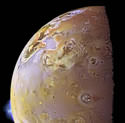
Image credit: NASA
A team of French and American astronomers have discovered the presence of salt (NaCl) in Io’s atmosphere. They think that the salt was ejected into the Jovian moon’s atmosphere by the many volcanos that ceaselessly bubble across its surface. The atmosphere of Io has been studied for several years now, first observed closely by the Voyager spacecraft, but this is the first time it’s been found to contain good old “table salt”.
The atmosphere of Jupiter’s moon Io is one of the most peculiar of the Solar System. In 1979, theVoyager spacecraft revealed active volcanism (Figure 1, left) at the surface of the satellite and discovered a local, tenuous SO2 atmosphere. Since 1990, millimeter-wave observations acquired at IRAM (French-German-Spanish telescope) and UV observations with HST provided a somewhat more detailed description of this atmosphere. The typical surface pressure is about 1 nanobar, and, in a unique fashion in the Solar System, the atmosphere exhibits strong horizontal variations, being apparently concentrated in an equatorial band.The main atmospheric compounds are SO2, SO and S2. The atmosphere is probably produced, on the one hand by direct volcanic output, and on the other hand by the sublimation of SO2 ices that cover Io’s surface.
However, it has been long suspected than Io’s atmosphere must contain other chemical species. As early as 1974, visible imaging and spectroscopy revealed a “cloud” of atomic sodium (Figure 1, right), roughly centered about Io’s orbit. Detailed subsequent studies of this cloud indicated a complex structure, including notably “fast sodium” features, for the production of which the role of molecular ions (NaX+ ) was evidenced. These discoveries naturally raised the question of the origin of sodium in Io’s environment. From the brightness of the optical emissions of Na, one can estimate that about 1026-1027 sodium atoms leave Io each second.
In 1999, chlorine in atomic and ionized form was discovered around Io, with an abundance comparable to that of sodium (while the cosmochemical abundance of Na is about 15 times that of Cl). This suggests a common origin, NaCl being a natural plausible parent of both. At the same time, on the basis of thermochemical equilibrium calculations, NaCl was proposed to be an important compound of Io’s volcanic magmas, with an abudance relative to SO2 as high as several percent.
Based on these discoveries and predictions, an observing campaign was conducted by E. Lellouch, from Paris Observatory, and several French and American colleagues at the IRAM 30-m radiotelescope in January 2002. Two rotational lines of NaCl at 143 and 234 GHz were unambiguously detected (Figure 2.). Because the vapor pressure of this salt is entirely negligible, NaCl cannot be in sublimation equilibrium with Io’s surface and its presence must directly result from continuous volcanic output. It appears to be a minor armospheric species. The most plausible physical model depicts the NaCl atmosphere as more localized than SO2, due to its very short lifetime (a few hours at most), and probably restricted to the volcanic centers. The local NaCl abundance in this model is 0.3-1.3 % of SO2, significantly lower than predicted. From the line strengths, volcanic emission rates of (2-8)x1028 NaCl molecules per second can be derived. According to photochemical and escape models, only a small fraction of these molecules escape from Io (about 0.1 %). A somewhat larger amount (1-2 %) leaves Io in atomic form after being photolyzed to Na and Cl. The vast majority of the volcanically-emitted NaCl molecules fall back to the surface where they condense out, potentially contributing to the white color of some of Io’s terrains. In conclusion, it appears that NaCl provides an importante source of sodium and chlorine in Io’s environment; however the precise chemical nature of the NaX+ molecular ions remains to be elucidated.
Original Source: Paris Observatory News Release
